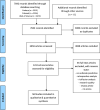Scoping future outbreaks: a scoping review on the outbreak prediction of the WHO Blueprint list of priority diseases
- PMID: 34531189
- PMCID: PMC8449939
- DOI: 10.1136/bmjgh-2021-006623
Scoping future outbreaks: a scoping review on the outbreak prediction of the WHO Blueprint list of priority diseases
Abstract
Background: The WHO's Research and Development Blueprint priority list designates emerging diseases with the potential to generate public health emergencies for which insufficient preventive solutions exist. The list aims to reduce the time to the availability of resources that can avert public health crises. The current SARS-CoV-2 pandemic illustrates that an effective method of mitigating such crises is the pre-emptive prediction of outbreaks. This scoping review thus aimed to map and identify the evidence available to predict future outbreaks of the Blueprint diseases.
Methods: We conducted a scoping review of PubMed, Embase and Web of Science related to the evidence predicting future outbreaks of Ebola and Marburg virus, Zika virus, Lassa fever, Nipah and Henipaviral disease, Rift Valley fever, Crimean-Congo haemorrhagic fever, Severe acute respiratory syndrome, Middle East respiratory syndrome and Disease X. Prediction methods, outbreak features predicted and implementation of predictions were evaluated. We conducted a narrative and quantitative evidence synthesis to highlight prediction methods that could be further investigated for the prevention of Blueprint diseases and COVID-19 outbreaks.
Results: Out of 3959 articles identified, we included 58 articles based on inclusion criteria. 5 major prediction methods emerged; the most frequent being spatio-temporal risk maps predicting outbreak risk periods and locations through vector and climate data. Stochastic models were predominant. Rift Valley fever was the most predicted disease. Diseases with complex sociocultural factors such as Ebola were often predicted through multifactorial risk-based estimations. 10% of models were implemented by health authorities. No article predicted Disease X outbreaks.
Conclusions: Spatiotemporal models for diseases with strong climatic and vectorial components, as in River Valley fever prediction, may currently best reduce the time to the availability of resources. A wide literature gap exists in the prediction of zoonoses with complex sociocultural and ecological dynamics such as Ebola, COVID-19 and especially Disease X.
Keywords: SARS; geographic information systems; mathematical modelling; systematic review; viral haemorrhagic fevers.
© Author(s) (or their employer(s)) 2021. Re-use permitted under CC BY-NC. No commercial re-use. See rights and permissions. Published by BMJ.
Conflict of interest statement
Competing interests: None declared.
Figures


Similar articles
-
Global research trends of World Health Organization's top eight emerging pathogens.Global Health. 2017 Feb 8;13(1):9. doi: 10.1186/s12992-017-0233-9. Global Health. 2017. PMID: 28179007 Free PMC article. Review.
-
Taking forward a 'One Health' approach for turning the tide against the Middle East respiratory syndrome coronavirus and other zoonotic pathogens with epidemic potential.Int J Infect Dis. 2016 Jun;47:5-9. doi: 10.1016/j.ijid.2016.06.012. Epub 2016 Jun 15. Int J Infect Dis. 2016. PMID: 27321961 Free PMC article.
-
A Review on Emerging Infectious Diseases Prioritized Under the 2018 WHO Research and Development Blueprint: Lessons from the Indian Context.Vector Borne Zoonotic Dis. 2021 Mar;21(3):149-159. doi: 10.1089/vbz.2020.2661. Epub 2020 Dec 14. Vector Borne Zoonotic Dis. 2021. PMID: 33316200 Review.
-
The WHO R&D Blueprint: 2018 review of emerging infectious diseases requiring urgent research and development efforts.Antiviral Res. 2018 Nov;159:63-67. doi: 10.1016/j.antiviral.2018.09.009. Epub 2018 Sep 24. Antiviral Res. 2018. PMID: 30261226 Free PMC article. Review.
-
World Health Organization Methodology to Prioritize Emerging Infectious Diseases in Need of Research and Development.Emerg Infect Dis. 2018 Sep;24(9):e171427. doi: 10.3201/eid2409.171427. Emerg Infect Dis. 2018. PMID: 30124424 Free PMC article.
Cited by
-
Emerging and reemerging infectious diseases: global trends and new strategies for their prevention and control.Signal Transduct Target Ther. 2024 Sep 11;9(1):223. doi: 10.1038/s41392-024-01917-x. Signal Transduct Target Ther. 2024. PMID: 39256346 Free PMC article. Review.
-
Mapping knowledge landscapes and emerging trends of Marburg virus: A text-mining study.Heliyon. 2024 Apr 15;10(8):e29691. doi: 10.1016/j.heliyon.2024.e29691. eCollection 2024 Apr 30. Heliyon. 2024. PMID: 38655363 Free PMC article.
-
Rift Valley Fever Virus: An Overview of the Current Status of Diagnostics.Biomedicines. 2024 Feb 28;12(3):540. doi: 10.3390/biomedicines12030540. Biomedicines. 2024. PMID: 38540153 Free PMC article. Review.
-
The Re-Emergence of Rift Valley Fever in Mananjary District, Madagascar in 2021: A Call for Action.Pathogens. 2024 Mar 16;13(3):257. doi: 10.3390/pathogens13030257. Pathogens. 2024. PMID: 38535600 Free PMC article.
-
Detection of Anti-Rift Valley Fever Virus Antibodies in Serum Samples of Patients with Suspected Arbovirus Infection.Microorganisms. 2023 Aug 14;11(8):2081. doi: 10.3390/microorganisms11082081. Microorganisms. 2023. PMID: 37630641 Free PMC article.
References
-
- WHO . Annual review of diseases prioritized under the. Geneva, Switzerland: Research and Development Blueprint, 2018.
-
- Garry RF. Current topics in microbiology and immunology. Curr Top Microbiol 2020:1–22https://www.springer.com/series/82 - PubMed
Publication types
MeSH terms
LinkOut - more resources
Full Text Sources
Medical
Miscellaneous
